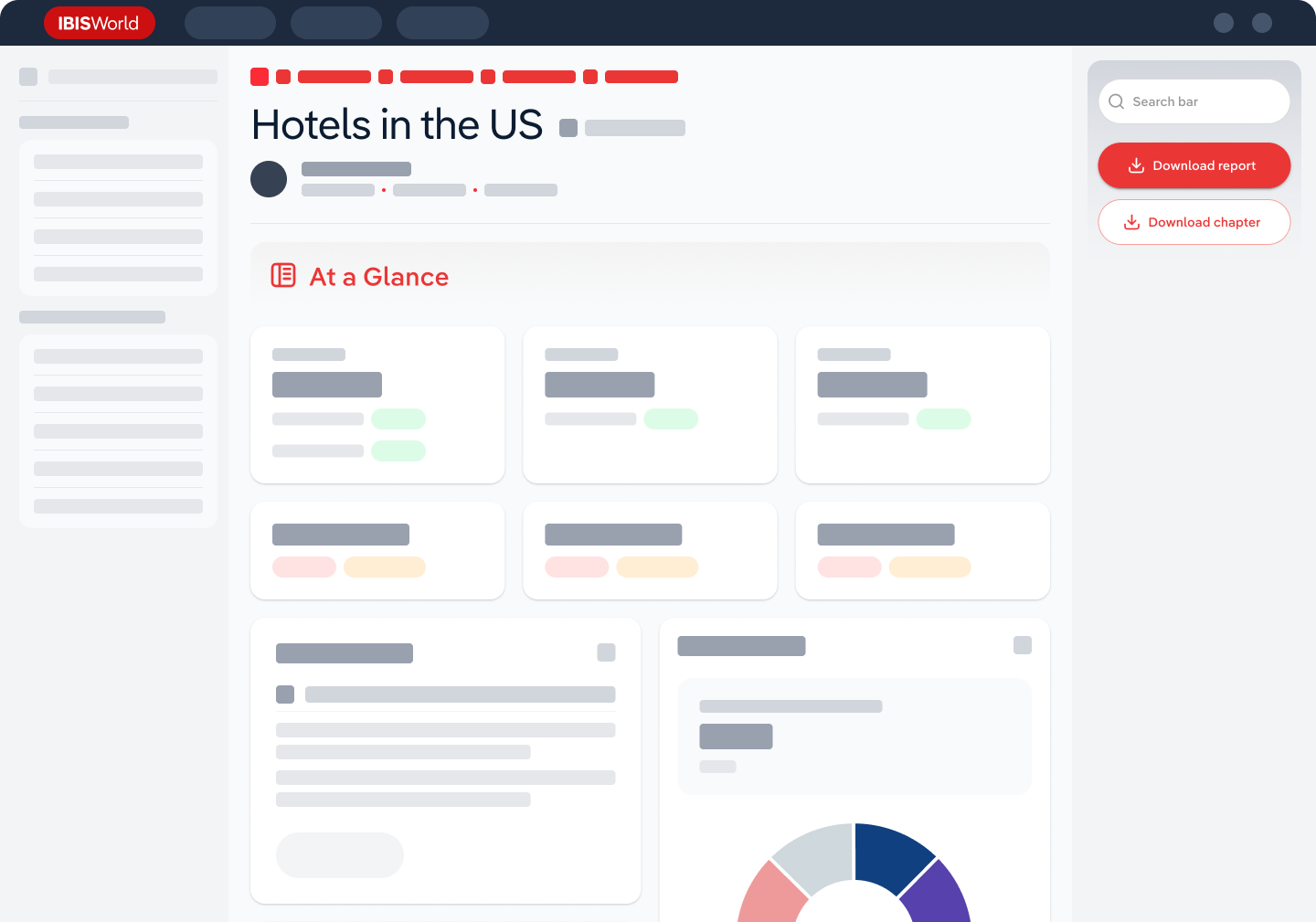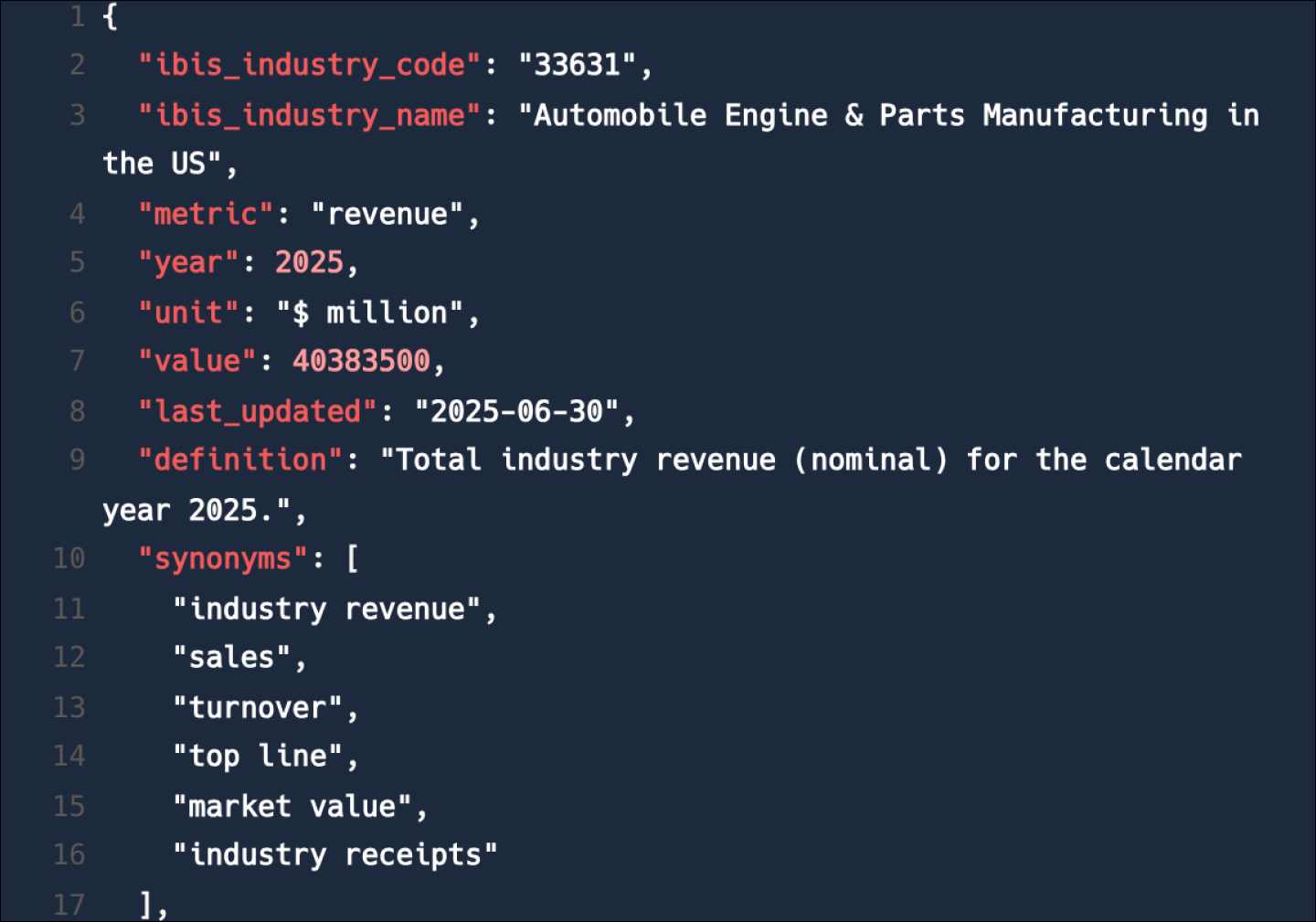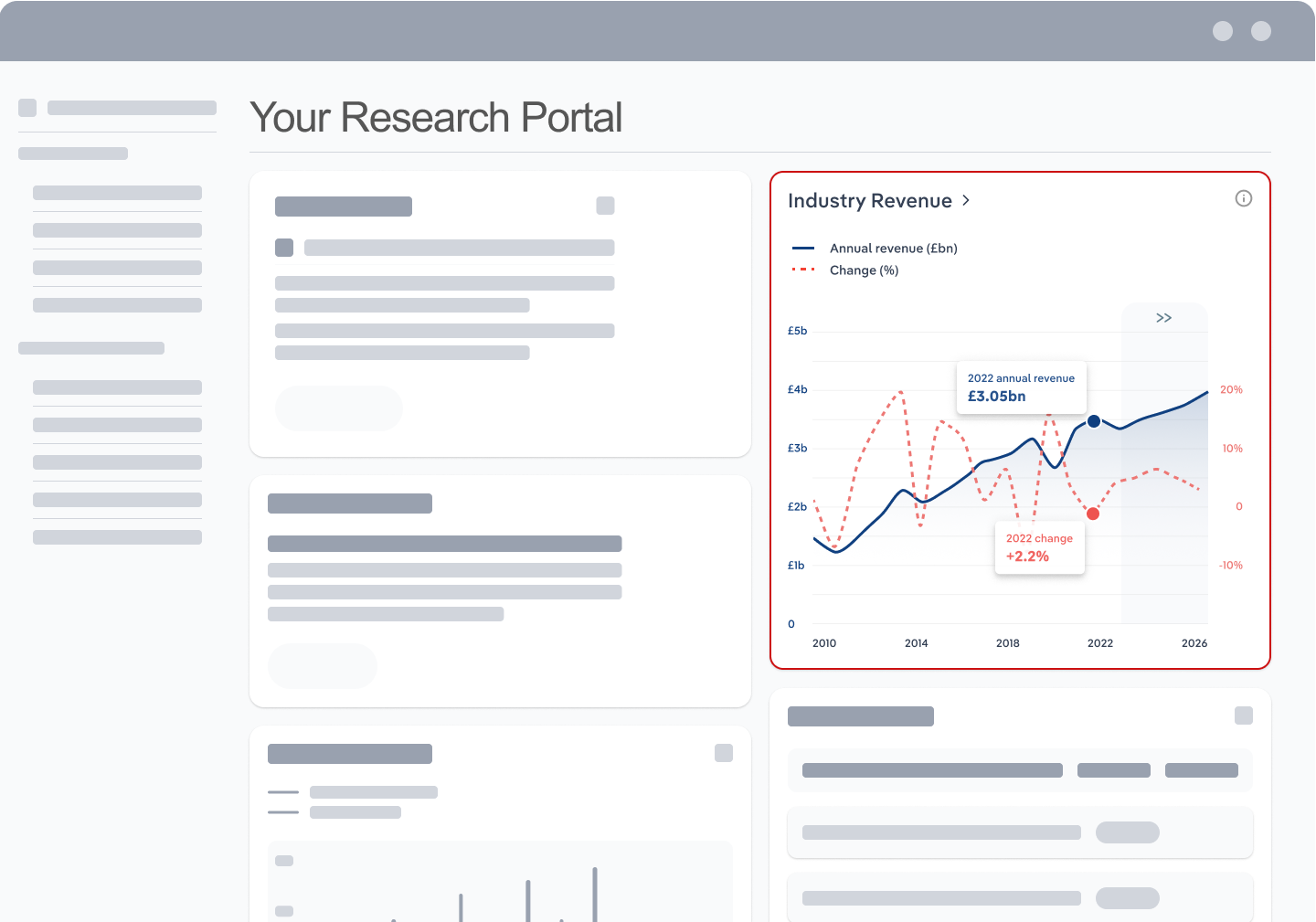Industry Statistics and Trends
Market size and recent performance (2015-2030)
Industry revenue has declined at a CAGR of 0.4 % over the past five years, to reach an estimated €16.2bn in 2025.
Trends and Insights
The industry is classified as basic chemicals and is strongly characterised by chlorine chemistry
- The sector is part of the domestic basic chemicals industry, which produces chemical elements and basic chemical compounds on an industrial scale and mostly in a continuous production process. In inorganic chemistry, value creation in the chlorine segment in particular plays a central role.
- Additional trends and insights available with purchase
Industry outlook (2025-2030)
Market size is projected to decline over the next five years.
Trends and Insights
Competition from foreign manufacturers of basic chemicals is likely to remain intense
- The situation for manufacturers of inorganic raw materials and chemicals is likely to remain tense in the coming years. The background to the ambivalent industry development is the increasing specialisation of the German chemical industry in the context of changes in the international division of labour in chemical production.
Biggest companies in the Inorganic Basic Chemical Manufacturing in Germany
| Company | Market Share (%)
2025 | Revenue (€m)
2025 |
|---|---|---|
Evonik Industries AG | 1,137.0 | |
Wacker Chemie AG | 1,045.0 | |
Orion Engineered Carbons GmbH | 759.0 |
To view the market share and analysis for all 6 top companies in this industry, view purchase options.
Products & Services Segmentation
Industry revenue is measured across several distinct product and services lines, including Chlorine, silicon, carbon black, Metal hydroxides and Inorganic salts and esters. Chlorine, silicon, carbon black is the largest segment of the Inorganic Basic Chemical Manufacturing in Germany.
Trends and Insights
The production of chlorine, silicon and carbon black is central to value creation in the industry
- Chlorine is a non-metal from the group of halogens that is highly reactive. It reacts with numerous elements as well as organic and inorganic compounds even at normal temperatures. This is why more than half of all products in the chemical industry are manufactured using chlorine. For example, it serves as the basic chemical for the production of the most important modern plastics. On an industrial scale, chlorine is mainly obtained from rock salt and water by means of chlor-alkali electrolysis.
- More insights available in the full report
Table of Contents
About this industry
Industry definition
The industry comprises the production of inorganic substances using basic technical processes. This includes, in particular, the production of chlorine, caustic soda and sulphuric acid. The industry includes the production of chemical elements with the exception of industrial gases and metals, the production of inorganic acids with the exception of nitric acid and the production of alkalis, lyes and other inorganic bases with the exception of ammonia.
What's included in this industry?
Products and services covered in the Inorganic Basic Chemical Manufacturing industry in Germany include Production of chemical elements with the exception of industrial gases and metals, Production of inorganic acids with the exception of nitric acid, Production of alkalis, lyes and other inorganic bases with the exception of ammonia and Production of other inorganic compounds.Companies
Companies covered in the Inorganic Basic Chemical Manufacturing industry in Germany include Evonik Industries AG, Wacker Chemie AG and Orion Engineered Carbons GmbH.Purchase this report to view all 6 major companies in this industry.
Related Terms
Related terms covered in the Inorganic Basic Chemical Manufacturing industry in Germany include industrial chemicals, cyclical industry, commodities, fine chemistry, inorganic chemicals, organic chemicals and petrochemistry.Industry Code
WZ 20.13 - Inorganic Basic Chemical Manufacturing in Germany
Performance
Get an indication of the industry's health through historical, current and forward-looking trends in the performance indicators that make or break businesses.
Analyst insights
The manufacture of industry products is comparatively expensive in Germany. In Germany as a production location, the energy-intensive industry is currently suffering from hig...
In this chapter (4)
- Current Performance
- Outlook
- Volatility
- Life Cycle
Key metrics
- Annual Revenue, Recent Growth, Forecast, Revenue Volatility
- Number of Employees, Recent Growth, Forecast, Employees per Business, Revenue per Employee
- Number of Businesses, Recent Growth, Forecast, Employees per Business, Revenue per Business
- Total Profit, Profit Margin, Profit per Business
Charts
- Revenue, including historical (2015-2024) and forecast (2025-2030)
- Employees, including historical (2015-2024) and forecast (2025-2030)
- Businesses, including historical (2015-2024) and forecast (2025-2030)
- Profit, including historical (2015-2025)
- Industry Volatility vs. Revenue Growth
- Industry Life Cycle
Detailed analysis
- Trends in supply, demand and current events that are driving current industry performance
- Expected trends, economic factors and ongoing events that drive the industry's outlook
- Key success factors for businesses to overcome volatility
- How contribution to GDP, industry saturation, innovation, consolidation, and technology and systems influence the industry's life cycle phase.
Products and Markets
Learn about an industry's products and services, markets and trends in international trade.
Analyst insight
Chlorine, silicon and carbon black are the most important product category in the industry. Over half of all products in the chemical industry are manufactured using chlorine...
In this chapter
- Products & Services
- Major Markets
- International Trade
Key metrics
- Largest market segment and value in 2025
- Product innovation level
- Total imports, level and trend
- Total exports, level and trend
- Trade Balance
Charts
- Products & services segmentation in 2025
- Major market segmentation in 2025
- International trade, including imports by country and exports by country
Detailed analysis
- Trends impacting the recent performance of the industry's various segments
- Innovations in the industry's product or service offering, specialization or delivery method
- Key factors that successful businesses consider in their offerings
- Buying segments and key trends influencing demand for industry products and services
- Recent trends in import and export volumes, country of origin or destination, and expected future trends
Geographic Breakdown
Discover where business activity is most concentrated in an industry and the factors driving these trends to find opportunities and conduct regional benchmarking.
Analyst insights
The Central region is home to the largest share of companies in the sector. As the chemical industry is strongly represented in the region, manufacturers of inorganic raw mat...
In this chapter (1)
- Business Locations
Charts
- Share of revenue, establishment, wages and employment in each region
- Share of population compared to establishments in each region in 2025
Tables
- Number and share of establishments in each region in 2025
- Number and share of revenue each region accounts for in 2025
- Number and share of wages each region accounts for in 2025
- Number and share of employees in each region in 2025
Detailed analysis
- Geographic spread of the industry across Europe, and trends associated with changes in the business landscape
- Key success factors for businesses to use location to their advantage
Competitive Forces
Get data and insights on what's driving competition in an industry and the challenges industry operators and new entrants may face, with analysis built around Porter's Five Forces framework.
Analyst insights
Competition in the industry is fierce. Chemical base materials are usually produced in large quantities and hardly allow for any differentiation, which is why trade in them i...
In this chapter (4)
- Concentration
- Barriers to Entry
- Substitutes
- Buyer & Supplier Analysis
Key metrics
- Industry concentration level
- Industry competition level and trend
- Barriers to entry level and trend
- Substitutes level and trend
- Buyer power level and trend
- Supplier power level and trend
Charts
- Market share concentration among the top 4 suppliers from 2020-2025
- Supply chain including upstream supplying industries and downstream buying industries, flow chart
Detailed analysis
- Factors impacting the industry’s level of concentration, such as business distribution, new entrants, or merger and acquisition activity.
- Key success factors for businesses to manage the competitive environment of the industry.
- Challenges that potential industry entrants face such as legal, start-up costs, differentiation, labor/capital intensity and capital expenses.
- Key success factors for potential entrants to overcome barriers to entry.
- Competitive threats from potential substitutes for the industry’s own products and services.
- Key success factors for how successful businesses can compete with substitutes.
- Advantages that buyers have to keep favorable purchasing conditions.
- Advantages that suppliers have to maintain favorable selling conditions.
- Key success factors for how businesses can navigate buyer and supplier power.
Companies
Learn about the performance of the top companies in the industry.
Analyst insights
Wacker Chemie AG is a key player in the inorganic raw materials and chemicals manufacturing industry. The company primarily supplies the solar and semiconductor industries wi...
In this chapter
- Market Share Concentration
- Companies
- Company Spotlights
Charts
- Industry market share by company in 2021 through 2025
- Major companies in the industry, including market share, revenue, profit and profit margin in 2025
- Overview of Evonik Industries AG's performance by revenue, market share and profit margin from 2019 through 2025
- Overview of Wacker Chemie AG's performance by revenue, market share and profit margin from 2019 through 2025
- Overview of Orion Engineered Carbons GmbH's performance by revenue, market share and profit margin from 2019 through 2025
- Overview of revenue, market share and profit margin trend for 3 additional companies
Detailed analysis
- Description and key data for Evonik Industries AG, and factors influencing its performance in the industry
- Description and key data for Wacker Chemie AG, and factors influencing its performance in the industry
- Description and key data for Orion Engineered Carbons GmbH, and factors influencing its performance in the industry
- Description, key data and performance trends for 3 additional companies
External Environment
Understand the demographic, economic and regulatory factors that shape how businesses in an industry perform.
Analyst insights
The demand for industry products depends on the development of industrial production. If the production volume increases, more inorganic raw materials and chemicals are usual...
In this chapter
- External Drivers
- Regulation & Policy
- Assistance
Key metrics
- Regulation & policy level and trend
- Assistance level and trend
Charts
- Regulation & Policy historical data and forecast (2015-2030)
- Assistance historical data and forecast (2015-2030)
Detailed analysis
- Demographic and macroeconomic factors influencing the industry, including Regulation & Policy and Assistance
- Major types of regulations, regulatory bodies, industry standards or specific regulations impacting requirements for industry operators
- Key governmental and non-governmental groups or policies that may provide some relief for industry operators.
Financial Benchmarks
View average costs for industry operators and compare financial data against an industry's financial benchmarks over time.
Analyst insights
The current high raw material and energy prices are reducing the industry's profitability. Price increases have been partially mitigated by hedging transactions, but passing ...
In this chapter
- Cost Structure
- Financial Ratios
- Key Ratios
Key metrics
- Profit margin, and how it compares to the sector-wide margin
- Average wages, and how it compares to the sector-wide average wage
- Largest cost component as a percentage of revenue
- Industry average ratios for days' receivables, industry coverage and debt-to-net-worth ratio
Charts
- Average industry operating costs as a share of revenue, including purchases, wages, depreciation, utilities, rent, other costs and profit in 2025
- Average sector operating costs as a share of revenue, including purchases, wages, depreciation, utilities, rent, other costs and profit in 2025
- Investment vs. share of economy
Data tables
- Cash Flow & Debt Service Ratios (2015-2030)
- Revenue per Employee (2015-2030)
- Revenue per Enterprise (2015-2030)
- Employees per Establishment (2015-2030)
- Employees per Enterprise (2015-2030)
- Average Wage (2015-2030)
- Wages/Revenue (2015-2030)
- Establishments per Enterprise (2015-2030)
- IVA/Revenue (2015-2030)
- Imports/Demand (2015-2030)
- Exports/Revenue (2015-2030)
Detailed analysis
- Trends in the cost component for industry operators and their impact on industry costs and profitability
Key Statistics
Industry Data
Data Tables
Including values and annual change:
- Revenue (2015-2030)
- IVA (2015-2030)
- Establishments (2015-2030)
- Enterprises (2015-2030)
- Employment (2015-2030)
- Exports (2015-2030)
- Imports (2015-2030)
- Wages (2015-2030)
Top Questions Answered
Unlock comprehensive answers and precise data upon purchase. View purchase options.
What is the market size of the Inorganic Basic Chemical Manufacturing industry in Germany in 2025?
The market size of the Inorganic Basic Chemical Manufacturing industry in Germany is €16.2bn in 2025.
How many businesses are there in the Inorganic Basic Chemical Manufacturing industry in Germany in 2025?
There are 69 businesses in the Inorganic Basic Chemical Manufacturing industry in Germany, which has declined at a CAGR of 0.8 % between 2020 and 2025.
How may import tariffs affect the Inorganic Basic Chemical Manufacturing industry in Germany?
The Inorganic Basic Chemical Manufacturing industry in Germany is likely to be significantly impacted by import tariffs with imports accounting for a high share of industry revenue.
How may export tariffs affect the Inorganic Basic Chemical Manufacturing industry in Germany?
The Inorganic Basic Chemical Manufacturing industry in Germany is likely to be significantly impacted by export tariffs with exports accounting for a high share of industry revenue.
Has the Inorganic Basic Chemical Manufacturing industry in Germany grown or declined over the past 5 years?
The market size of the Inorganic Basic Chemical Manufacturing industry in Germany has been declining at a CAGR of 0.4 % between 2020 and 2025.
What is the forecast growth of the Inorganic Basic Chemical Manufacturing industry in Germany over the next 5 years?
Over the next five years, the Inorganic Basic Chemical Manufacturing industry in Germany is expected to decline.
What are the biggest companies in the Inorganic Basic Chemical Manufacturing industry in Germany?
The biggest companies operating in the Inorganic Basic Chemical Manufacturing industry in Germany are Evonik Industries AG, Wacker Chemie AG and Orion Engineered Carbons GmbH
What does the Inorganic Basic Chemical Manufacturing industry in Germany include?
Production of chemical elements with the exception of industrial gases and metals and Production of inorganic acids with the exception of nitric acid are part of the Inorganic Basic Chemical Manufacturing industry in Germany.
Which companies have the highest market share in the Inorganic Basic Chemical Manufacturing industry in Germany?
The company holding the most market share in the Inorganic Basic Chemical Manufacturing industry in Germany is Evonik Industries AG.
How competitive is the Inorganic Basic Chemical Manufacturing industry in Germany?
The level of competition is high and steady in the Inorganic Basic Chemical Manufacturing industry in Germany.
Methodology
How are IBISWorld reports created?
IBISWorld has been a leading provider of trusted industry research for over 50 years to the most successful companies worldwide. With offices in Australia, the United States, the United Kingdom, Germany and China, we are proud to have local teams of analysts that conduct research, data analysis and forecasting to produce data-driven industry reports.
Our analysts start with official, verified and publicly available sources of data to build the most accurate picture of each industry. Analysts then leverage their expertise and knowledge of the local markets to synthesize trends into digestible content for IBISWorld readers. Finally, each report is reviewed by one of IBISWorld’s editors, who provide quality assurance to ensure accuracy and readability.
IBISWorld relies on human-verified data and human-written analysis to compile each standard industry report. We do not use generative AI tools to write insights, although members can choose to leverage AI-based tools within the platform to generate additional analysis formats.
What data sources do IBISWorld analysts use?
Each industry report incorporates data and research from government databases, industry-specific sources, industry contacts, and our own proprietary database of statistics and analysis to provide balanced, independent and accurate insights.
Key data sources in Germany include:
- German Federal Statistics Office (Destatis)
- European Statistics Office (Eurostat)
- United Nations Comtrade
Analysts also use industry specific sources to complement catch-all sources, although their perspective may focus on a particular organization or representative body, rather than a clear overview of all industry operations. However, when balanced against other perspectives, industry-specific sources provide insights into industry trends.
These sources include:
- Industry and trade associations
- Industry federations or regulators
- Major industry players annual or quarterly filings
Finally, IBISWorld’s global data scientists maintain a proprietary database of macroeconomic and demand drivers, which our analysts use to help inform industry data and trends. They also maintain a database of statistics and analysis on thousands of industries, which has been built over our more than 50-year history and offers comprehensive insights into long-term trends.
How does IBISWorld forecast its data?
IBISWorld’s analysts and data scientists use the sources above to create forecasts for our proprietary datasets and industry statistics. Depending on the dataset, they may use regression analysis, multivariate analysis, time-series analysis or exponential smoothing techniques to project future data for the industry or driver. Additionally, analysts will leverage their local knowledge of industry operating and regulatory conditions to impart their best judgment on the forecast model.
IBISWorld prides itself on being a trusted, independent source of data, with over 50 years of experience building and maintaining rich datasets and forecasting tools. We are proud to be the keystone source of industry information for thousands of companies across the world.
Learn more about our methodology and data sourcing on the Help Center.










